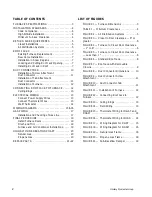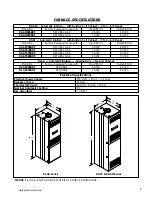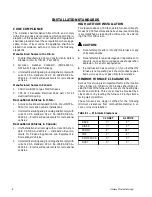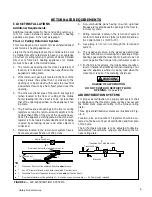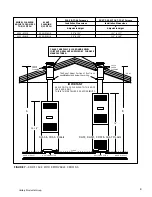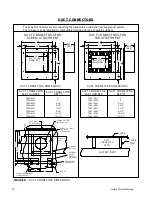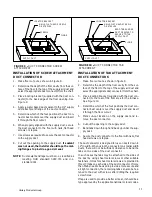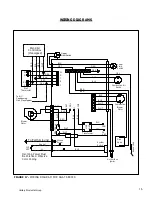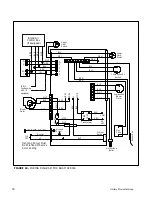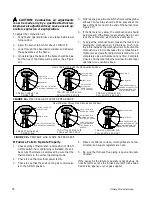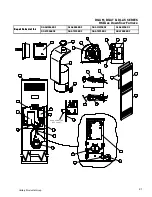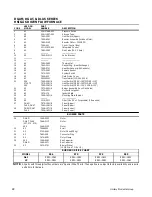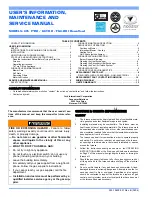
7
Unitary Products Group
ROOF JACKS
FAILURE TO FOLLOW ALL VENTING IN-
STRUCTION CAN RESULT IN FIRE ASPHYXI-
ATION, OR EXPLOSION.
CAUTION:
Only use the appropriate roof jack.
See Figures 6 & 7 for correct application.
Do not exceed the maximum height as determined
from Figures 2 & 3. Installer should allow an addi-
tional 1-
1
/
2
” travel before the flue pipe assembly is
fully extended against the built- in stop. This pro-
vides an additional safeguard against the flue as-
sembly being pulled from the roof jack during trans-
portation or other stress conditions.
EXISTING FURNACE REPLACEMENT
If this furnace replaces an
exciting furnace
, do the fol-
lowing:
1. If a 2
nd
roof, roof cap or addition has been made to
the existing roof of the home,
remove the old roof
jack completely!... to avoid the possibility of an
improperly installed pipe or gaps in the old roof
jack, INSTALL A NEW ROOF JACK. Your ceiling
and roof height will determine the correct roof
jack to use. Refer to the vent selection table, of
the furnace installation instructions.
2. After unpacking the roof jack, check the rain caps.
Insure they are not damaged, tilted or crooked.
Do
not twist, crush or sit on the roof caps during
installation.
Damaged roof caps will cause improp-
er furnace operation. The furnace will not heat prop-
erly and could result in explosion.
3. Before inserting the roof jack into the furnace top, in-
spect the furnace flue and combustion air opening
for debris or insulation which might have fallen in
during pre--installation steps. Do not proceed unless
all debris have been cleaned out or removed.
4. After installing roof jack on furnace top collar, check
to make sure there is no gap in back or side between
the pipe collar and the furnace casing top.
5. Use only the pipes provided with the roof jack as-
sembly. Do not add to or adapt other sheet metal
pipes.
Do not cut, insert or add other pipes to this
assembly.
6. In no case should there be a gap between sections
of the flue pipe or the combustion air pipe. If neces-
sary to prevent excessive air leakage, the installer
should seal joints in the combustion air tube with alu-
minum type or other suitable sealant.
NEW HOME INSTALLATION
If this furnace is installed on a new home do the following:
1. Inspect the furnace top collars for signs of insulation
or ceiling debris which might have fallen in during
cutting of the ceiling and roof holes. Remove all de-
bris before continuing.
2. After unpacking the roof jack, check the rain caps.
Insure they are not damaged, tilted or crooked.
Do
not twist, crush or sit on the roof caps during
installation.
Damaged roof caps will cause improp-
er furnace operation. The furnace will not heat prop-
erly and could result in explosion.
3. Before inserting the vent pipe into the furnace top,
inspect the furnace flue and combustion air opening
for debris or insulation which have fallen in during
pre--installation steps. Do not proceed unless all de-
bris have been cleaned out or removed.
4. After installing roof jack on furnace top collar, check
to make sure there is no gap in back or side between
the pipe collar and the furnace casing top. If neces-
sary to prevent excessive air leakage, the installer
should seal joints in the combustion air tube with alu-
minum type or other suitable sealant.
INSTALLATION IN SNOW REGIONS
When the combustion air pipe inlet is covered or blocked
with snow, the furnace will not operate properly due to
the depleted combustion air supply.
Therefore, if the furnace will be located in regions where
snow accumulation on the roof exceeds 7” or in H.U.D.
Snow Load Zones, a roof jack extension (Part No.
7680B6541) is recommended.
LOCATING AND CUTTING ROOF JACK
OPENING
To facilitate the proper installation of the roof jack, it is
very important that the roof jack opening in the ceiling
and roof be on the same vertical center line as the fur-
nace flue collar. See Figure 8.
Mark this location on ceiling and scribe a circle with a 5”
radius (10” diameter) around this mark. Cut opening for
roof jack through ceiling and roof.
(If furnace was in-
stalled during construction, cover furnace and flue
opening to prevent debris from entering flue when
hole is cut for roof jack.)
INSTALLING ROOF JACK IN ROOF
(See Figure 6 & 7 for Dimensional requirements.)
Insert roof jack into opening in the roof.
The roof jack should be secured to the furnace be-
fore roof flange (flashing) is secured to the roof.
This
will insure a better alignment of the flue pipe and furnace
flue collar. Caulk around and under roof flange to provide
a water tight seal, before securing roof jack flashing to
roof.
Summary of Contents for DLAS
Page 23: ...23 Unitary Products Group...


